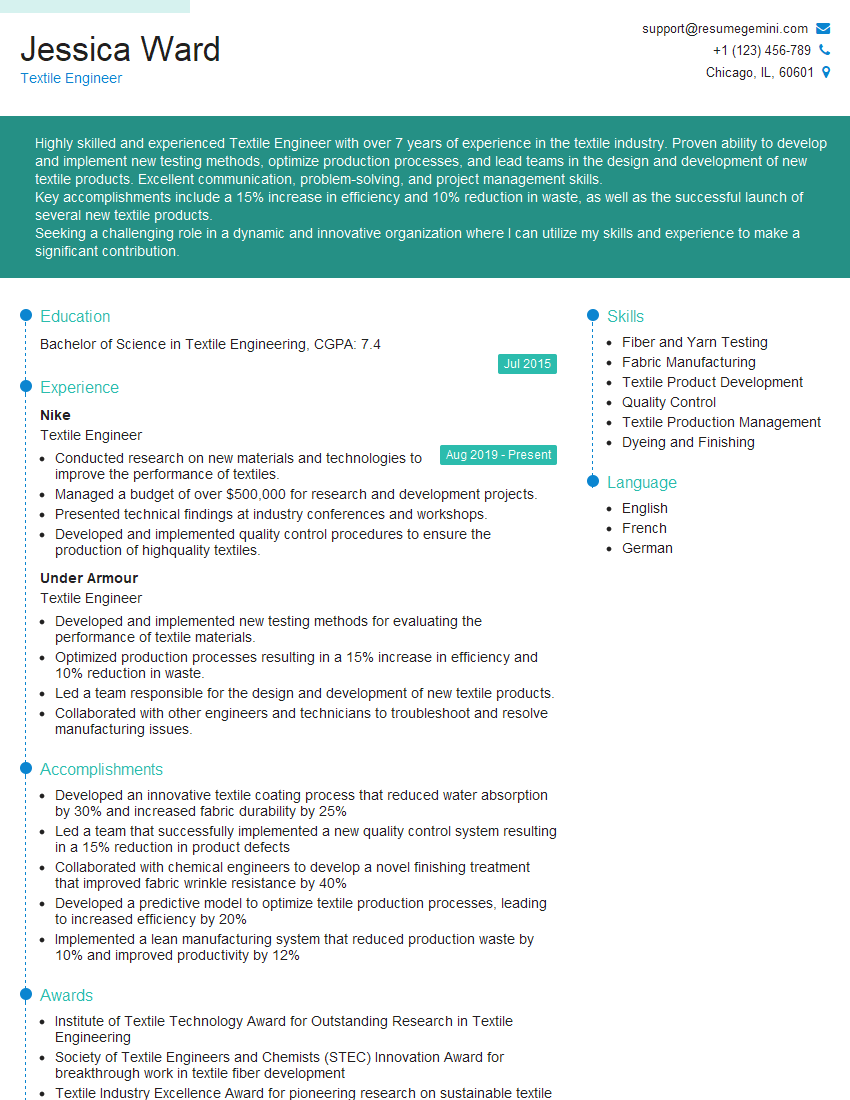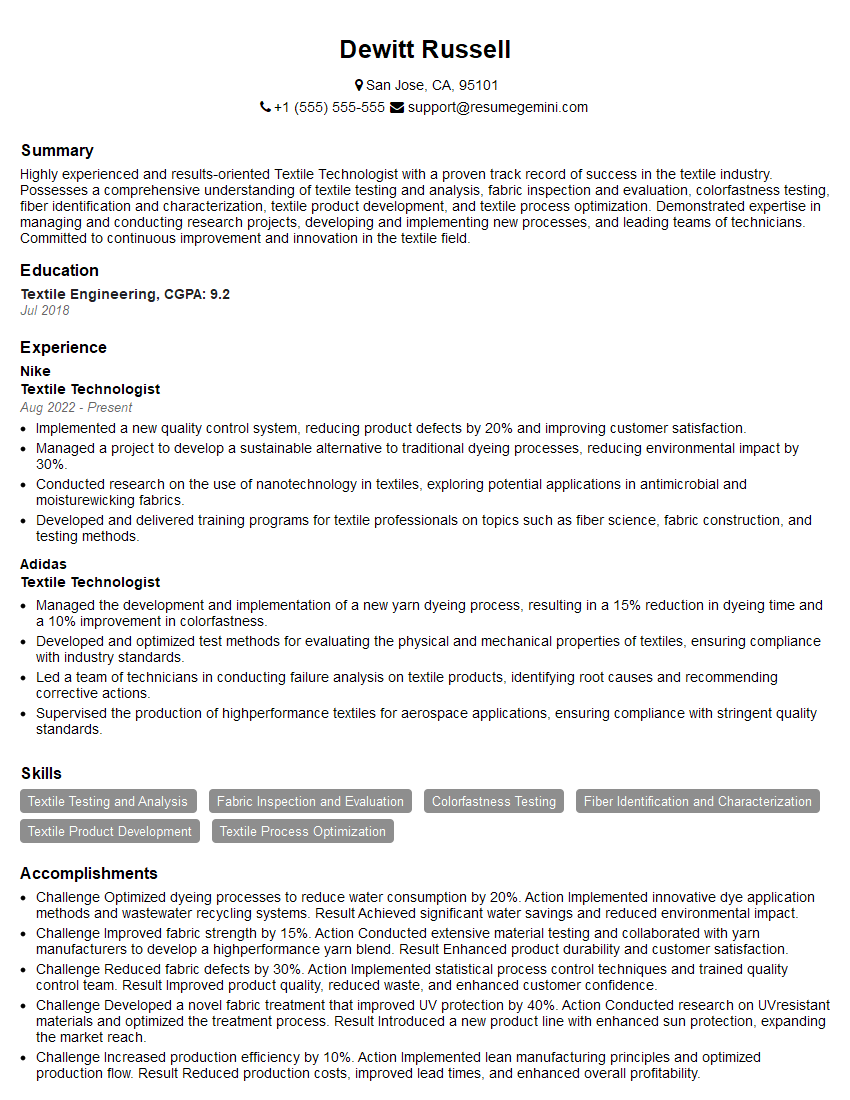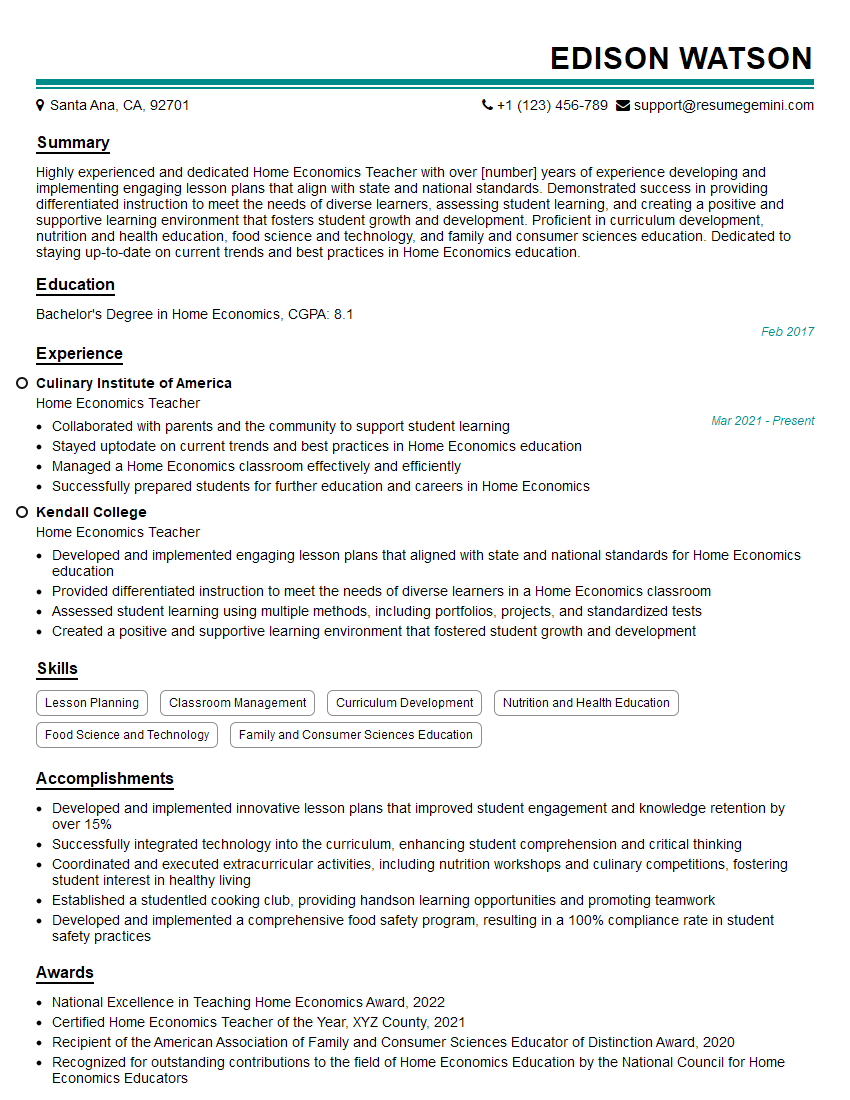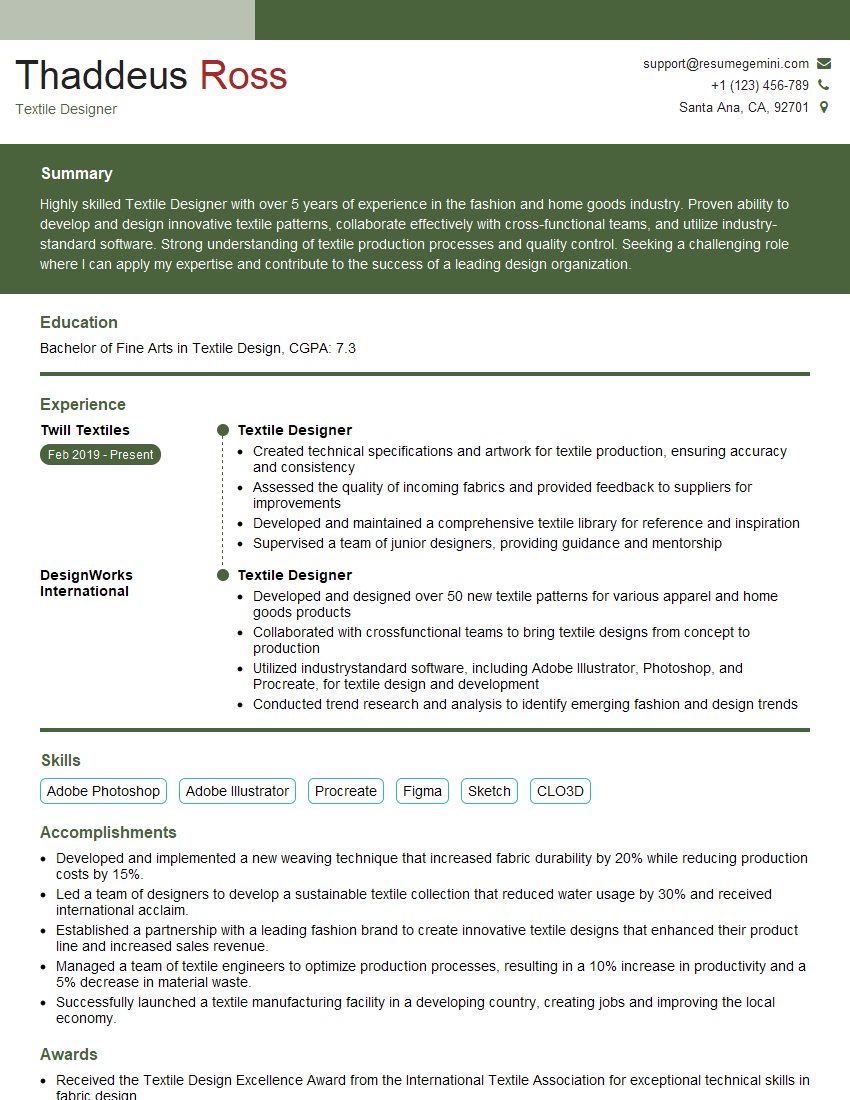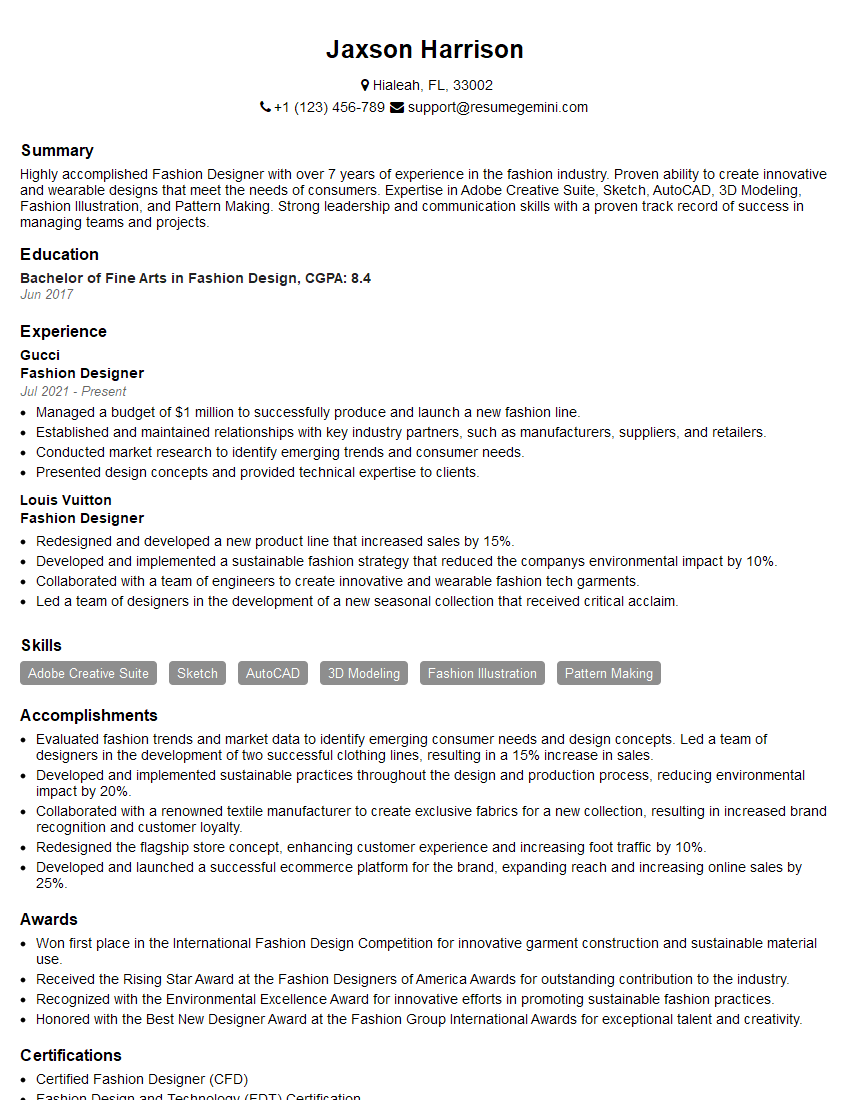The thought of an interview can be nerve-wracking, but the right preparation can make all the difference. Explore this comprehensive guide to Knowledge of different fabrics and their ironing requirements interview questions and gain the confidence you need to showcase your abilities and secure the role.
Questions Asked in Knowledge of different fabrics and their ironing requirements Interview
Q 1. What are the differences between natural and synthetic fibers in terms of ironing?
Natural fibers, like cotton, linen, wool, and silk, have unique ironing properties compared to synthetics like polyester, nylon, or rayon. Natural fibers tend to absorb more moisture, making them wrinkle more easily but also easier to iron out those wrinkles with steam. However, they are also more susceptible to damage from excessive heat. Synthetics, on the other hand, often require lower ironing temperatures and are less prone to scorching, but wrinkles can be more stubborn and sometimes require specialized techniques like pressing instead of ironing. Think of it like this: natural fibers are like sponges – they absorb and release moisture readily, making them pliable when ironed. Synthetics are more like plastics – they hold their shape more stubbornly and can melt or become shiny with too much heat.
- Natural Fibers: Generally require higher temperatures and more steam, but are more forgiving of occasional mishaps.
- Synthetic Fibers: Require lower temperatures and less steam; excessive heat can cause melting or shine.
Q 2. Explain the proper ironing technique for linen.
Linen is a strong, beautiful natural fiber known for its crisp texture. Proper ironing is key to maintaining this quality. Always iron linen while it’s still slightly damp. This makes the wrinkles easier to smooth out. A high heat setting is usually appropriate, but always check the care label. Iron on the wrong side (reverse) if possible to avoid creating a shine on the surface. Use a lot of steam! Begin by ironing seams and then move onto the rest of the garment. A pressing cloth is helpful to prevent shine and scorching, particularly on dark colors. For stubborn creases, try using a steam burst and gently stretching the linen as you iron.
Think of it like this: you’re not just ironing the wrinkles out; you’re coaxing the fibers back into their intended shape.
Q 3. How would you iron a garment with delicate embellishments?
Garments with delicate embellishments like beading, sequins, or embroidery require extra care. Always iron these garments inside out to protect the embellishments. Use a low to medium heat setting and a pressing cloth to cushion the delicate areas. Avoid directly applying the iron to the embellishments, as the heat can damage or melt them. For particularly delicate items, consider steaming instead of ironing. Hold the steamer a few inches away from the garment and let the steam gently smooth the wrinkles. If you’re unsure, test a small, inconspicuous area first to ensure the heat setting doesn’t harm the embellishments.
Imagine you’re treating the garment like a fragile work of art—gentle care is essential.
Q 4. What temperature setting should be used to iron silk?
Silk is a luxurious natural fiber that requires a very low heat setting for ironing. Too much heat can cause irreparable damage, such as scorching or yellowing. Always use the lowest setting on your iron, or even better, use a cool iron or steam. Iron on the wrong side, using a pressing cloth to prevent shine or damage to the fabric. It’s often better to steam silk instead of ironing it directly. If you must iron, work quickly and avoid lingering in one spot.
Remember, silk is delicate and temperamental; gentleness is key.
Q 5. What are the risks of ironing at too high a temperature?
Ironing at too high a temperature can have several detrimental effects on your garments. The most common is scorching, which creates unsightly brown marks that are difficult, if not impossible, to remove. Depending on the fabric, high heat can also cause melting, shrinking, or discoloration. Synthetic fabrics are particularly vulnerable to this. For natural fabrics, high heat can damage the fibers, weakening the fabric and making it less durable over time. Always check the care label before ironing and err on the side of caution by using a lower temperature if you’re unsure.
Think of it as cooking – too much heat burns the food!
Q 6. How do you prevent scorching when ironing?
Preventing scorching involves several simple yet effective techniques. Always check the care label for ironing instructions. Use a pressing cloth between the iron and the garment, particularly for delicate fabrics or dark colors. This acts as a buffer, preventing direct heat contact. Iron on the wrong side of the garment whenever possible. Lower the iron’s temperature if you suspect it is too high. Don’t let the iron sit in one place for too long. Keep the iron moving constantly to distribute the heat evenly and prevent any localized overheating.
Prevention is far better than cure when it comes to ironing damage.
Q 7. How do you remove wrinkles from velvet without damaging the fabric?
Velvet is a delicate fabric with a soft pile, which makes it prone to crushing and damage from heat. Ironing velvet directly is generally discouraged. Instead, the best way to remove wrinkles is by steaming. Use a hand-held steamer, holding it several inches away from the fabric. Let the steam gently lift the wrinkles without direct contact. For stubborn wrinkles, you can use a very low heat setting and a pressing cloth, but proceed with extreme caution. Always work on the wrong side of the velvet if possible, and test a small, inconspicuous area first. Another option is to hang the garment in a steamy bathroom for a while; the moisture in the air may help to release the wrinkles.
Think of it as pampering the velvet—gentle persuasion is the key.
Q 8. What are the differences between pressing and ironing?
Pressing and ironing are often used interchangeably, but they are distinct techniques. Ironing involves moving the iron back and forth across the fabric, primarily to smooth wrinkles. Pressing, on the other hand, involves placing the iron on the fabric and lifting it, applying pressure to flatten seams and creases. Think of ironing as a broad smoothing action, and pressing as a more precise, targeted technique for achieving a crisp finish.
For example, you’d iron a large tablecloth to remove wrinkles, while you’d press the seams of a tailored suit to create sharp, clean lines. Pressing generally results in a more professional finish.
Q 9. How would you iron a garment with pleats?
Ironing pleated garments requires careful attention to detail to maintain the pleats’ integrity. Begin by checking the garment’s care label for specific instructions. Generally, you should iron the pleats from the wrong side of the fabric, using a low to medium heat setting. Use a pressing cloth to protect delicate fabrics. To avoid flattening the pleats, carefully press along each fold, supporting the fabric underneath with your hand or a tailor’s ham to prevent creasing.
For instance, when ironing a pleated skirt, place a tailor’s ham (a padded form) under the pleats to maintain their shape while you press the fabric’s surface. Always work in small sections, pressing only one pleat at a time.
Q 10. Describe how to iron a shirt with a collar and cuffs.
Ironing a shirt requires a systematic approach. Start with the collar, pressing it from the wrong side first to set the shape. Then, iron the right side of the collar, taking care not to stretch it. Next, iron the cuffs, again starting from the wrong side. Press the placket (the front opening) and then the sleeves, working from the shoulder to the cuff, smoothing any wrinkles. Finally, iron the front and back of the shirt, working in sections.
A useful tip is to iron the sleeves while they’re still slightly damp, pulling them taut to avoid creases. Use a low-to-medium heat setting, depending on the shirt’s fabric. Remember to always check the care label before you begin.
Q 11. What fabrics should never be ironed?
Several fabrics should never be ironed directly. These include materials like leather, suede, silk (certain types), and some synthetic fabrics like those labeled ‘dry clean only’. High heat can damage these fabrics, causing irreversible shrinking, scorching, or melting. For these materials, consider steam cleaning or professional dry cleaning.
For example, attempting to iron leather will likely leave scorch marks or alter the texture permanently. Always refer to the care label as your guide.
Q 12. How can you determine the appropriate ironing temperature for an unknown fabric?
Determining the correct ironing temperature for an unknown fabric can be done through a simple test. Iron a small, inconspicuous area of the fabric on a low setting. Gradually increase the heat setting, testing on another inconspicuous area until you find the ideal temperature. You’ll know you’ve reached the right setting when the fabric smooths without scorching or showing signs of damage. If unsure, it’s always safer to start with a lower temperature and gradually increase.
Think of it like baking— you wouldn’t start by throwing a cake in at the highest setting! Always test in a hidden spot first, like the inside seam.
Q 13. What are some common fabric finishes and how do they affect ironing?
Various fabric finishes influence ironing techniques. A pre-shrunk fabric will require less ironing, while a non-pre-shrunk fabric might shrink with high heat. A crease-resistant finish reduces the need for ironing, while a water-resistant finish may require lower heat or steam. A stiff finish may need to be pressed firmly to remove wrinkles without damaging it. Always check the care label for specific information.
For instance, wrinkle-resistant fabrics are designed to minimize wrinkling and are often easy to iron. Conversely, stiff fabrics like linen may need careful pressing with a press cloth to retain their structure.
Q 14. How can you identify fabric blends and adapt your ironing technique accordingly?
Identifying fabric blends requires careful examination of the garment’s care label. Blends often combine natural and synthetic fibers, each with unique ironing requirements. The care label usually indicates the percentage of each fiber. The fiber requiring the lowest ironing temperature typically determines the overall ironing temperature. Use a low to medium heat and a pressing cloth to be safe.
For example, a 50/50 cotton/polyester blend would likely be ironed at a medium temperature, as polyester melts at high temperatures. Always err on the side of caution; a lower temperature setting is preferable.
Q 15. Explain the use of a pressing cloth.
A pressing cloth is a thin, heat-resistant fabric placed between the iron and the garment. Think of it as a protective barrier. It’s crucial for preventing scorching, especially on delicate fabrics like silk, wool, or rayon, or garments with embellishments like sequins or embroidery. The cloth absorbs excess moisture and heat, ensuring even distribution and preventing shiny marks or damage.
How it works: The pressing cloth acts like a buffer, preventing direct contact between the hot iron and the potentially vulnerable garment surface. The heat transfers through the cloth, gently smoothing wrinkles.
Example: Imagine ironing a silk blouse. Without a pressing cloth, the intense heat of the iron could melt the fibers or leave an unsightly sheen. A pressing cloth provides a safe and effective way to remove wrinkles without damaging the delicate fabric.
Career Expert Tips:
- Ace those interviews! Prepare effectively by reviewing the Top 50 Most Common Interview Questions on ResumeGemini.
- Navigate your job search with confidence! Explore a wide range of Career Tips on ResumeGemini. Learn about common challenges and recommendations to overcome them.
- Craft the perfect resume! Master the Art of Resume Writing with ResumeGemini’s guide. Showcase your unique qualifications and achievements effectively.
- Don’t miss out on holiday savings! Build your dream resume with ResumeGemini’s ATS optimized templates.
Q 16. Describe the proper way to use a steam iron.
Using a steam iron involves more than just turning it on. It’s about mastering the technique for optimal results and garment care. First, fill the water reservoir with distilled water (tap water can leave mineral deposits). Then, select the appropriate temperature setting based on the fabric type. Always test a hidden area first, especially with delicate items. Once the iron is heated and ready, hold the iron with a comfortable grip, ensuring your hand isn’t touching the hot metal surfaces.
Proper Technique: Glide the iron smoothly over the fabric, moving in the direction of the weave (check the garment’s care label for specific instructions). Steam is your friend—it loosens fibers making wrinkle removal more efficient. For stubborn creases, hold the iron briefly in place, allowing the steam to penetrate. For vertical creases, such as those on pants legs, use the steam function to quickly and effectively smooth out the fabric. Always let the garment cool completely before folding or storing to set the press.
Example: Ironing a linen shirt requires a higher heat setting compared to ironing a delicate lace doily. The steam function is effective in both cases but needs less time on more delicate fabrics.
Q 17. What are the advantages and disadvantages of using a dry iron?
Dry irons are simpler, less expensive, and easier to maintain compared to steam irons. However, they lack the penetrating power of steam, making them less effective on stubborn wrinkles and thick fabrics. They are also more likely to scorch fabrics if the heat isn’t carefully controlled.
- Advantages: Simple to use and maintain, less expensive.
- Disadvantages: Less effective on stubborn wrinkles and thicker fabrics, higher risk of scorching if misused, slower ironing process compared to steam iron.
Example: A dry iron is suitable for lightly wrinkled cotton shirts but might struggle with a heavily creased wool suit. In such cases a steam iron would be more effective.
Q 18. How do you treat stubborn wrinkles in different fabrics?
Stubborn wrinkles require a multi-pronged approach tailored to the fabric. Always start by checking the care label for specific instructions.
- Cotton and Linen: Higher heat settings and steam are generally safe. For extreme creases, try dampening the area slightly before ironing.
- Silk and Wool: Use a low heat setting and a pressing cloth. Avoid direct heat contact as it can damage the fibers. Steam is best applied cautiously.
- Synthetics: Moderate heat and light steaming. Avoid excessive heat which can melt or distort the fibers.
- Delicate Fabrics: Use a low heat setting, a pressing cloth, and minimal steam, or consider steaming only. Some delicate fabrics require professional dry-cleaning.
Example: A heavily creased linen tablecloth might need a damp cloth and a higher heat setting with plenty of steam. However, a silk scarf would necessitate a low setting, a pressing cloth, and very light steaming or even just pressing (no steam).
Q 19. What are some common ironing mistakes and how to avoid them?
Common ironing mistakes often stem from improper temperature settings or techniques.
- Using the wrong temperature: Always check the garment’s care label for recommended heat settings. Too high a temperature can scorch the fabric; too low a temperature may leave wrinkles unaffected.
- Ironing without a pressing cloth: This can result in shiny marks or scorch marks, especially on delicate fabrics.
- Not letting the iron cool down: An excessively hot iron can lead to damage.
- Ignoring the weave direction: Ironing against the grain of the fabric can make it look wrinkled or misshapen.
- Over-ironing: Ironing the same area repeatedly can flatten and damage the fabric.
How to avoid them: Always check care labels, use a pressing cloth for sensitive fabrics, test a hidden area to verify temperature, iron with the grain, and avoid over-ironing by using a gentle touch and moving methodically.
Q 20. How can you maintain the shape and structure of garments during ironing?
Maintaining the shape and structure of garments during ironing involves careful techniques and attention to detail.
- Use garment-specific ironing boards: Pants or sleeve boards help maintain creases and shapes.
- Iron with the grain: Following the natural direction of the fabric helps prevent unwanted stretching or distortion.
- Use steam appropriately: Steam can help set creases in pants and other garments, but too much steam can cause over-stretching.
- Press seams open (when appropriate): For tailored garments, pressing seams open can help create a clean, crisp finish.
- Pay attention to details: Ensure buttons and zippers are secured to avoid damage or distortion. Iron collars and cuffs carefully to maintain their shape.
Example: To maintain the crisp pleats on a skirt, iron each pleat individually using a pleat board, ensuring to avoid overlapping them.
Q 21. What safety precautions should be taken when ironing?
Ironing safety is paramount. Always follow these precautions:
- Never leave a hot iron unattended: Always unplug the iron when not actively using it.
- Keep the iron away from flammable materials: Avoid ironing near curtains, rugs, or other combustible items.
- Use caution with steam: Avoid direct contact with the steam as it can be hot. Keep children and pets away from the ironing area.
- Handle the iron carefully: Avoid touching the hot plate or other metal parts.
- Allow the iron to cool completely before storing: Always let the iron cool completely before placing it away to prevent accidents or damage.
Example: Before storing the iron, ensure that it’s completely switched off and allowed to cool fully, ideally on a heat-resistant surface.
Q 22. How do you remove iron scorch marks?
Removing iron scorch marks depends on the fabric and severity of the damage. For minor scorch marks on cotton or linen, try gently rubbing the area with a damp cloth and then ironing again with a lower heat setting. For more stubborn marks, consider using a paste of baking soda and water applied to the scorch mark. Let it dry completely, then brush off the residue and iron. For delicate fabrics like silk or wool, professional cleaning is often the safest option as home remedies can cause further damage. Remember, prevention is key; always check the fabric care label before ironing and use the appropriate heat setting.
Q 23. What are the different types of irons available and their suitability for different fabrics?
Several types of irons cater to different needs. Dry irons are suitable for fabrics that don’t require steaming, like linen or cotton. Steam irons offer both dry and steam ironing options, ideal for removing wrinkles from various materials including synthetics. Steam generators provide a powerful, consistent steam output perfect for thick fabrics or heavily creased garments. Lastly, travel irons are compact and lightweight for easy portability but may lack the power of full-size irons. Choosing the right iron hinges on fabric type and the volume of ironing needed. For instance, a steam generator is excellent for large families ironing a variety of garments, but for a single person with delicate items, a smaller dry or steam iron might be sufficient.
Q 24. How do you care for your iron to ensure its longevity and effectiveness?
Proper iron care ensures longevity and optimal performance. After each use, empty the water reservoir to prevent mineral build-up that can lead to staining and reduced steam output. Wipe down the soleplate with a damp cloth to remove any residue. For stubborn stains, use a specialized iron cleaner following the manufacturer’s instructions. Store your iron upright to prevent damage to the soleplate and internal components. Regular descaling, ideally every few months depending on water hardness, is vital for maintaining optimal steam production. Descaling solutions or white vinegar can be used as per the manufacturer’s recommendations.
Q 25. What are some common problems encountered during ironing and their solutions?
Common ironing problems include sticking, shiny patches, and uneven ironing. Sticking usually occurs due to a dirty soleplate or too much starch. Clean the soleplate thoroughly and reduce the starch application. Shiny patches, particularly on dark fabrics, are caused by excessive heat. Lower the iron’s temperature and use a pressing cloth. Uneven ironing can result from incorrect temperature settings or insufficient steam. Adjust the heat according to the fabric type and utilize the steam function for smoother results. Always test a hidden area first to check the heat setting and any possible effects on the fabric.
Q 26. Explain the concept of ‘heat setting’ on an iron and its significance.
The ‘heat setting’ on an iron corresponds to the temperature at which the iron operates. Different fabrics require different heat levels to avoid damage or insufficient wrinkle removal. Lower settings are appropriate for delicate materials like silk or wool; medium settings are suitable for cotton and linen; and higher settings may be needed for heavier fabrics like denim. The heat setting is crucial as incorrect temperatures can cause burning, scorching, or leave creases, compromising the quality and appearance of the garment. Always refer to the garment care label for specific heat recommendations.
Q 27. How does the moisture content of the fabric affect the ironing process?
The moisture content of a fabric significantly impacts ironing. Damp fabrics iron easier because the heat and moisture help to relax the fibers and remove wrinkles. Dry fabrics often require more effort and may scorch more easily at high temperatures. For best results, slightly dampen fabrics before ironing or use the steam function of your iron. The level of dampness is crucial though; too much moisture can lead to excessive watermarks. Therefore, test a small area first and allow any excess moisture to evaporate before proceeding with the full ironing process.
Q 28. What are the environmental considerations related to fabric care and ironing?
Environmental considerations in fabric care and ironing include water and energy consumption. Excessive water use during ironing and cleaning can impact water resources. Employing energy-efficient irons and only ironing when necessary reduces energy consumption. Choosing durable, sustainable fabrics that require less frequent washing and ironing minimizes overall environmental impact. Consider using eco-friendly detergents and avoiding harsh chemicals in cleaning processes. Air-drying garments whenever possible reduces reliance on energy-intensive machines.
Key Topics to Learn for Knowledge of Different Fabrics and Their Ironing Requirements Interview
- Fabric Identification: Learn to identify common fabrics (cotton, linen, silk, wool, polyester, blends) by sight and touch. Understand the fiber composition and its impact on ironing.
- Ironing Temperature Settings: Master the correlation between fabric type and appropriate iron temperature. Know how to use different settings (low, medium, high) and avoid damaging delicate fabrics.
- Ironing Techniques: Practice different ironing techniques for various fabrics, including pressing, steaming, and using a pressing cloth. Understand how to handle wrinkles and creases effectively.
- Fabric Care Symbols: Become proficient in interpreting laundry care symbols, particularly those related to ironing. This demonstrates attention to detail and a commitment to following instructions.
- Problem-Solving: Prepare examples of how you’ve successfully ironed challenging fabrics or resolved ironing-related issues. This showcases your problem-solving skills and practical experience.
- Stain Removal & Pre-Treatment: Understand how different stains might affect ironing and how to pre-treat fabrics before ironing to prevent setting stains or damage.
- Advanced Techniques (Optional): Explore advanced techniques such as using a tailor’s ham or point presser for intricate garment details. This demonstrates a higher level of expertise.
Next Steps
Mastering the knowledge of different fabrics and their ironing requirements is crucial for success in roles requiring attention to detail, technical skills, and a practical understanding of textile care. This expertise demonstrates professionalism and a commitment to quality workmanship. To significantly boost your job prospects, create an ATS-friendly resume that highlights your skills and experience effectively. ResumeGemini is a trusted resource that can help you build a compelling and professional resume tailored to your specific skills and experience. Examples of resumes tailored to demonstrating expertise in Knowledge of different fabrics and their ironing requirements are available to guide you.
Explore more articles
Users Rating of Our Blogs
Share Your Experience
We value your feedback! Please rate our content and share your thoughts (optional).
What Readers Say About Our Blog
Hello,
We found issues with your domain’s email setup that may be sending your messages to spam or blocking them completely. InboxShield Mini shows you how to fix it in minutes — no tech skills required.
Scan your domain now for details: https://inboxshield-mini.com/
— Adam @ InboxShield Mini
Reply STOP to unsubscribe
Hi, are you owner of interviewgemini.com? What if I told you I could help you find extra time in your schedule, reconnect with leads you didn’t even realize you missed, and bring in more “I want to work with you” conversations, without increasing your ad spend or hiring a full-time employee?
All with a flexible, budget-friendly service that could easily pay for itself. Sounds good?
Would it be nice to jump on a quick 10-minute call so I can show you exactly how we make this work?
Best,
Hapei
Marketing Director
Hey, I know you’re the owner of interviewgemini.com. I’ll be quick.
Fundraising for your business is tough and time-consuming. We make it easier by guaranteeing two private investor meetings each month, for six months. No demos, no pitch events – just direct introductions to active investors matched to your startup.
If youR17;re raising, this could help you build real momentum. Want me to send more info?
Hi, I represent an SEO company that specialises in getting you AI citations and higher rankings on Google. I’d like to offer you a 100% free SEO audit for your website. Would you be interested?
Hi, I represent an SEO company that specialises in getting you AI citations and higher rankings on Google. I’d like to offer you a 100% free SEO audit for your website. Would you be interested?
good
